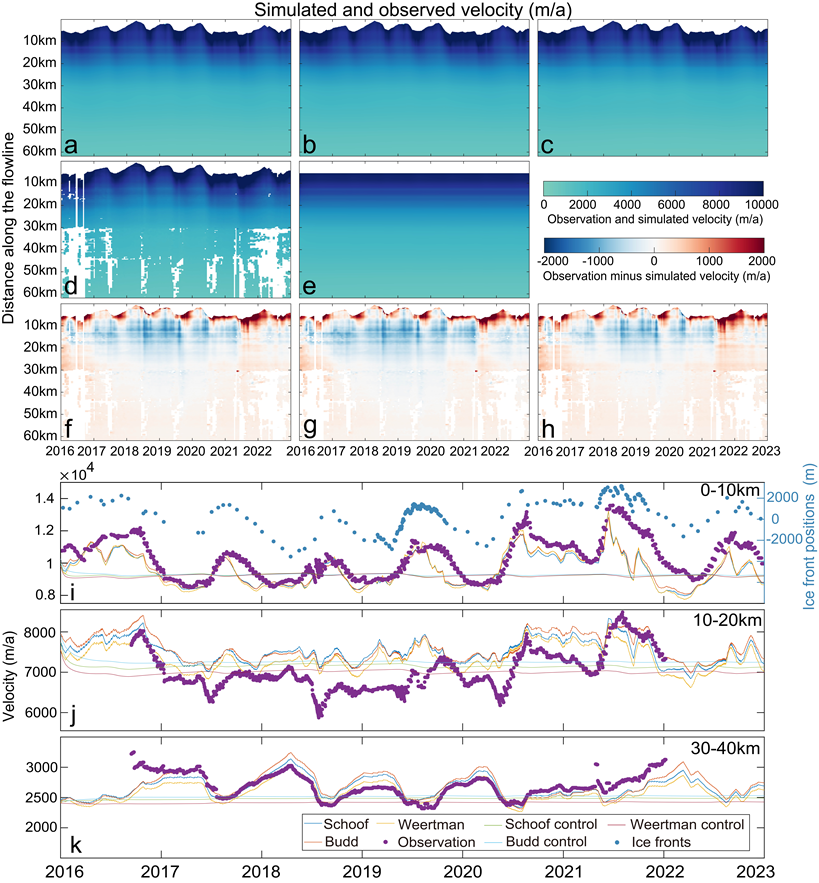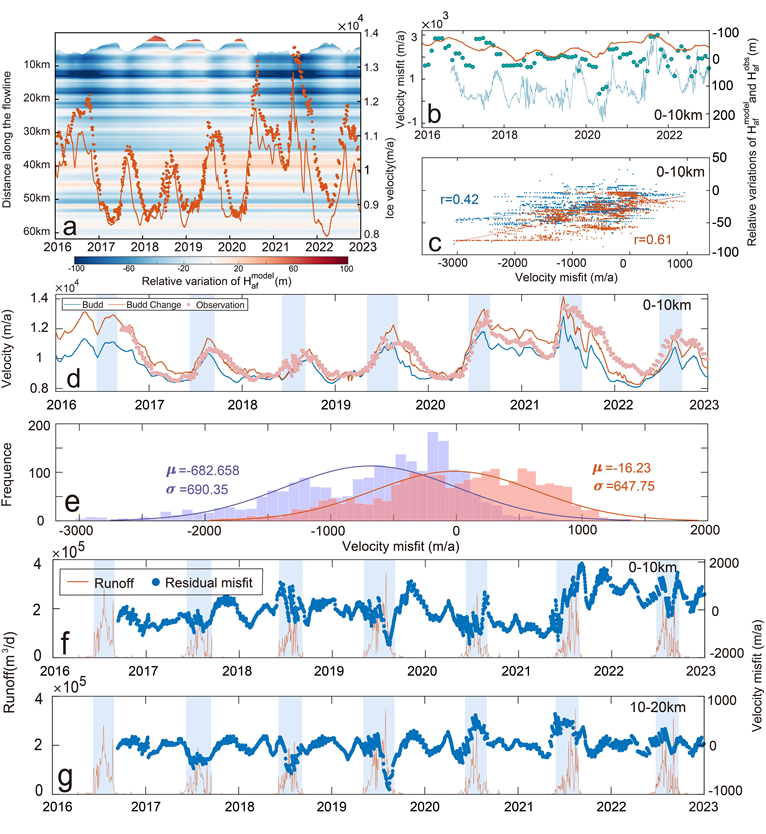Recently, the research team led by JIANG Liming from the Innovation Academy for Precision Measurement Science and Technology (APM), in collaboration with international scientific institutions including the University of Sheffield in the UK, Dartmouth College in the USA, and Durham University in the UK, successfully reconstructed and conducted an in-depth analysis of the dynamic changes and driving mechanisms of Jakobshavn Isbræ Glacier (also known as Sermeq Kujalleq) in Greenland from 2016 to 2022, based on high-resolution remote sensing data and the ISSM ice flow model. The study revealed the complex impacts of glacier terminus retreat, ice thickness changes, and subglacial hydrological processes on ice flow velocity variations, significantly enhancing the applicability of glacier dynamics models in predicting the future evolution of the Greenland ice sheet and global sea-level rise. The research findings were recently published in the internationally renowned journal Geophysical Research Letters, which is indexed by Nature Index.
The Greenland Ice Sheet (GrIS) is the second-largest ice body globally and plays a pivotal role in global sea-level changes by discharging ice mass through outlet glaciers into the ocean. Observations and numerical simulations indicate that the retreat and acceleration of Greenland's glaciers have led to intensified mass loss of the ice cap. Since the end of the 20th century, this process has contributed to 66±8% of the total mass loss from Greenland, equivalent to approximately 9.1 millimeters of global sea-level rise. However, the motion mechanisms of outlet glaciers are extremely complex, regulated by multiple factors such as glacier terminus retreat, ice thickness changes, basal friction, and subglacial hydrological processes. One of the core challenges in glacier dynamics research is how to accurately simulate these critical processes. The research team utilized high-spatiotemporal-resolution remote sensing data to extract changes in the terminus position of Jakobshavn Glacier, combined with remote sensing monitoring products for various key ice flow processes, and employed the ISSM ice flow model to conduct detailed modeling of seasonal and interannual variations from 2016 to 2022.

Figures a-e present the comparison and control experiments between simulated and observed ice flow velocities. Figures f-h illustrate the differences between the two. Figures i-k provide a comparative analysis within the range of 0-40 km.
The study found that when the observed sub-monthly glacier terminus positions were used as forcing conditions, the model could reproduce about 76% of the velocity variations. Within the 0-10 km range from the glacier terminus, the error between modeled and observed velocities was significantly correlated with changes in the "height above floatation" (Haf). Haf, serving as a proxy variable for effective pressure changes, could explain over 90% of the error within the 0-10 km range from the glacier terminus when incorporated into the model. After considering transient changes in basal friction and effective pressure variations due to ice thickness in the model, the peak of surface runoff variations coincided with the residual error in velocity, indicating that the short-term impact of surface melting on ice velocity was less than 10%. The research revealed that the velocity variations of Jakobshavn Isbræ Glacier were primarily driven by changes in terminus position, but seasonal variations in effective pressure and basal conditions caused by changes in ice thickness and subglacial hydrological processes also had significant impacts on its interannual and seasonal acceleration. As the glacier retreats into deeper basins, its sensitivity to seasonal effective pressure changes will persist. This study is the first to systematically quantify the impacts of terminus retreat, ice thickness changes, and hydrological processes on Greenland glacier dynamics, and emphasizes the importance of accurately parameterizing subglacial effective pressure in numerical models. The research findings will improve the prediction accuracy of the future evolution of the Greenland Ice Sheet and provide a more reliable scientific basis for assessing global sea-level rise.

Figures a-c show the comparison between Haf variations and ice flow velocities. Figures d-e demonstrate the changes in results after incorporating Haf variations into the model. Figures f-g present the comparison between the residual differences in observed and simulated flow velocities and runoff variations.
The study, titled "Ice Thickness-Induced Variations in Effective Pressure and Basal Conditions Influence Seasonal and Multi-Annual Ice Velocity at Sermeq Kujalleq (Jakobshavn Isbræ)", was published online, with APM serving as the lead institution. Researcher JIANG Liming is the corresponding author, and doctoral student LU Qian is the first author of the paper.
This research was supported and funded by the National Key Research and Development Program of China, the Strategic Priority Research Program of the Chinese Academy of Sciences, and the National Natural Science Foundation of China.
Link to the article: https://agupubs.onlinelibrary.wiley.com/doi/10.1029/2024GL111092
